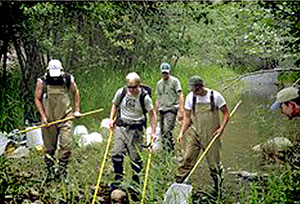- Reclamation
- Columbia-Pacific Northwest Region
- Programs & Activities
- Federal Columbia River Power System
- Tributary Habitat Research, Monitoring, & Evaluation
Federal Columbia River Power System
Tributary Habitat Research, Monitoring and Evaluation
FCRPS Home | Hydrosystem | Hatcheries | Tributary Habitat Program | Tributary Habitat RME | Fish Accords

Reclamations Tributary Habitat RME program is focused on carrying out the requirements of the FCRPS 2008 Biological Opinion in the Methow Basin in Washington State. The Pacific Northwest Region has invested substantial resources in implementing Columbia River tributary habitat improvements that support the 2008 biological opinions recommended actions. Reclamation’s monitoring efforts are meant to evaluate tributary habitat conditions, tributary habitat action effectiveness, and to use that knowledge to improve the biological effectiveness of future habitat improvement actions.
Reclamation’s Methow Subbasin Intensively Monitored Watershed Program (Methow IMW)
Tributary habitat improvement effectiveness monitoring efforts in the middle reach (M2) of the Methow River were initiated by the U.S. Bureau of Reclamation (USBR), in partnership with the U.S. Geological Survey (USGS) beginning in 2009. This initial monitoring effort focused on documenting pre-treatment fish population and stream habitat conditions in the M2 reach over a three year period (2009-2012). Plans were developed to continue this monitoring during a post enhancement phase (2013-2016) in order to investigate the reach-level response of the fish and habitat to the habitat enhancement efforts. This monitoring ended lapsed in 2013, was resumed in 2015, and has been completed.
The components of the current monitoring effort are described below and consist of an intensively monitored watershed demonstration report, before and after treatments studies, and a biological model development and use.
Intensively Monitored Watershed Demonstration Report
This report would summarize the Beaver Creek studies, the Whitefish Island and 3R projects efforts, the modeling effort, and any other work conducted by Reclamation during the BiOp period in the Methow Basin. The report will include a “lessons learned” section.
Before-after-control-impact (BACI) studies
These studies will evaluate the effectiveness of the Whitefish Island and 3R tributary habitat improvement projects for Upper Columbia (UC) spring chinook and steelhead. There are three components to the BACI studies – fish, habitat, and food web. The “pre” conditions are summarized in Bellmore reports and previously published USGS reports.
ISU Food Web Analysis Study
This study will address the relationships between habitat improvement and fish population changes through an investigation of the mechanisms (physical habitat, prey resources, or food web interactions) causing the change.
Trophic and Life Cycle Models
A food web model will be used as a tool to evaluate responses to habitat improvement projects and will be used to evaluate the biological uplift among alternatives for an ongoing habitat project. It also will be tested to determine watershed carrying capacity using CHaMP data. Products from this effort will be published papers, model results, and potential use as a tool for habitat project alternative evaluation.
Future RME Program
The future program will likely cover hydrosystem, hatchery, and predator control activities in addition to tributary habitat action monitoring. In addition, it is likely that the tributary habitat components of the program will move away from research and toward basic monitoring tied more closely to tributary habitat project needs. Further, science will be front loaded into project development to incorporate the target species biological requirements. To the extent possible, tools developed to date would continue to be used and supported.
Related Documents
| Grande Ronde Watersheds | |
| 07/2016 | Estimation of Catherine Creek Chinook Salmon Reach-Specific Survival During Spring Emigration PDF 2.45 mb |
| 09/2015 | Grande Ronde River Report PDF 16.09 mb |
| 05/2014 | Identification and Characterization of Catherine Creek Juvenile Spring Chinook Salmon Overwintering Rearing Habitat in Upper Grande Ronde Valley PDF 2.37 mb |
| 02/2012 | Fisheries Monitoring System: Catherine Creek PIT Tag Interrogation Systems PDF 791 kb |
| Upper Salmon Watershed | |
| 01/2016 | Riparian Habitat Management Plan: Upper Lemhi River, Leadore, ID PDF 6.04 mb |
| 02/2013 | Yankee Fork Drainage Fisheries Summary and Analysis PDF 2.26 mb |
| 2010 | Jordan River 2010 Stream Survey Report, Salmon-Challis National Forest PDF 2.93 mb |
Related Links
Columbia Habitat Monitoring Program (CHaMP)
Integrated Status and Effectiveness Monitoring Program (ISEMP)
Pacific Northwest Aquatic Monitoring Partnership (PNAMP)
NOAA Northwest Fisheries Science Center
Columbia Basin Fish and Wildlife Program
Contact
Public Affairs Office
pninfo@usbr.gov
208-378-6231
Bureau of Reclamation
Columbia-Pacific Northwest Region
1150 N Curtis Road, Suite 100
Boise, Idaho 83706

